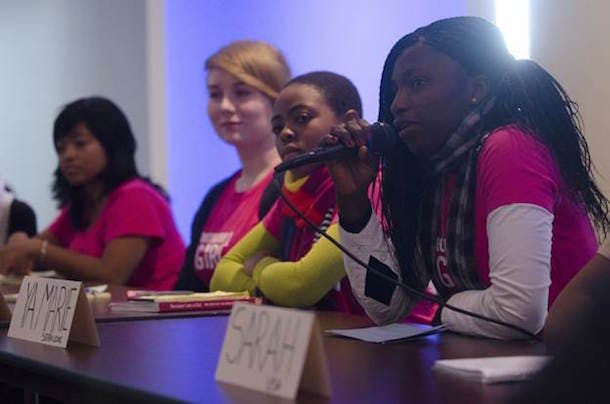
Editor’s Note: This post is part of the blog series, “Her Goals: Our Future,” which highlights the connections between girls and women and the Sustainable Development Goals. Guest blogger views expressed here do not necessarily reflect the views of the UN Foundation.
In 2007, Plan launched the Because I am Girl campaign at a time when the international development community began to unite around adolescent girls. Over the past nine years, adolescent girls have been thrust to the forefront of the development agenda, yet at the same time they are largely absent at the decision-making table. All too often we attend panels, workshops, and forums – from New York to Nairobi – that are about adolescent girls, but don’t actually include their voices, opinions, or participation. The era of engaging adolescent girls solely as program participants is long over, and as we shift our focus to the Sustainable Development Goals (SDGs), it’s time we invest in a process that allows girls to speak for themselves.
A few years into Because I am a Girl, we made a strategic decision to ensure that adolescent girls’ voices would be at the forefront of our efforts, from advocacy to programming, and what quickly ensued was the “get me a girl” phenomenon.
Plan and many other likeminded organizations started pushing our partners and donors to make space for girls to participate at places like the United Nations General Assembly, the Commission on the Status of Women, and the African Union – and with that girl-centered advocacy came the expectation that we could produce a girl on a moment’s notice.
A lot of people in the development industry want girls speaking for themselves, voicing their experiences and their ideas on how to abolish the barriers that hold them back. But not everyone is thinking critically about what it takes to get a girl from her community to the General Assembly of the United Nations in New York, in a way that puts her well-being and her agenda at the center.
The “get me a girl” mentality puts girls, their families, and our organizations at risk, and the good intentions that come with getting them at the table do not make up for the rushed, sometimes sloppy process that can ensue. Plucking a girl out of her community and expecting her to speak ably at a high-level forum, with little preparation and no strategic process, is a recipe for disaster.
When Plan made the commitment to get girls at the table we had to develop a process that put girls and their well-being, interests, and protection at the center. Girls in our programs are never there to serve Plan’s agenda. We’re there to serve theirs, and that mentality needs to be the driving force behind any advocacy initiative in which we engage girls.

There are several key activities recommended to ensure that girls have a positive, meaningful experience that builds their capacity, prepares them to participate, and above all prioritizes protection.
1. If the event requires international travel, three to six months is necessary to prepare. Giving your staff plenty of time to source passports, visas, meet with families, and prepare the girls in-country will make the process much smoother.
2. Implement a peer selection process. When girls are selected by their peers it creates a system of support and buy-in from a larger group and puts the decision making power in their hands. It minimizes jealousy, resentment, and the cultivation of hand-picked “stars” within the organization.
3. Girls should always travel in pairs, regardless of how many speakers are needed. This helps them navigate and process an intense experience, particularly for girls who have never left their community, and adds an additional layer of support and protection for the girl.
4. In-country orientation and speech preparation is necessary to orient youth to the country and the forum, and to fully prepare the girls to speak their own words and participate in a way that is youth friendly and empowering.
5. The event should provide space for meaningful youth participation. Girls in our programs are not spokespeople, and the engagement should include a broader itinerary that is developed in partnership with the participating girls. Engagements with youth clubs and schools are always recommended.
Many of us fought hard to get girls’ agenda at the center of the SDGs, and if we’re committed to getting girls a seat at the decision-making table, we must move beyond “get me a girl” and invest in a meaningful process. Because, seriously, “get me a girl” is so 15 years ago.
By Laura Brazee, Program Manager for Youth & Economic Empowerment Practice at Plan International USA
Photo credits: PR Newswire/Bartram Nason



 View All Blog Posts
View All Blog Posts